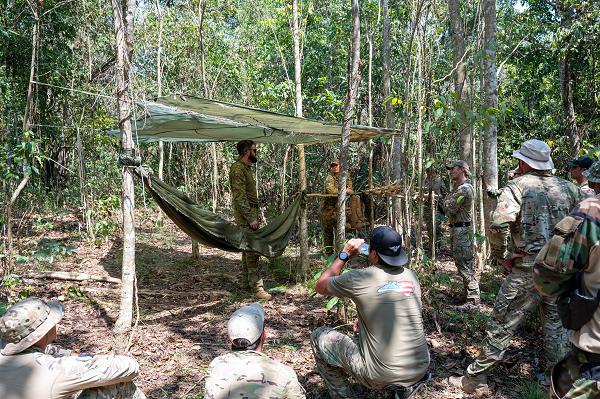
Port Moresby, Papua New Guinea. (September 1, 2024): What would you do if you found yourself stranded in the wilderness and in need of shelter? In this photo by Airman 1st Class Carson Jeney, Royal Australian Air Force Corporal Anthony Ross, an instructor with the Australian Defense Force Combat Survival School, demonstrates a variety of well-built shelters used in survival scenarios. The training involved the U.S. Air Force and the Papua New Guinea Defense Force during exercise Pacific Angel 24, an annual exercise to share knowledge of survival, evasion, resistance, and escape techniques.
A typical scenario involved downed pilots who suddenly find themselves in an unfamiliar wilderness where they are forced to survive with minimal gear or resources. The number one priority in such a situation is to seek adequate shelter from the elements while hiding your presence from the enemy.
Combat survival schools advise seeking out natural features like caves or rock overhangs can be easily made into good survival shelters. It is not advisable, according to these experts, to build a fire inside a cave because it may cause rocks overhead to dislodge and possible kill you. Other natural shelters include fallen trees that create a canopy to block the wind and rain. Finding a ready-made survival shelter saves a lot of time and energy which allows more time to seek food and water.
If no caves or overhangs are available, there are a couple of handy types of structures that can be quickly assembled using natural materials such as branches, leaves, moss, or large leafed plants. It is important that your structure “gets you off the ground” above possible flooding. This is why it is important to never build on low ground or close to a body of water. Other important considerations are the direction of the wind and the sun’s location.
The shelter design should be specific to the elements one is facing. In a jungle area prone to rain, waterproofing is the priority. In freezing snow, insulation is key to escaping the wind and trapping warmth. In the desert, a cave or outcropping is the most likely place to get out of the sun. Even without a handy cave, piling rocks and sand over a trench can accomplish the same goal.
Thanks to training events like these, America’s warfighters will have the knowledge and skills needed to survive in virtually any environment.


